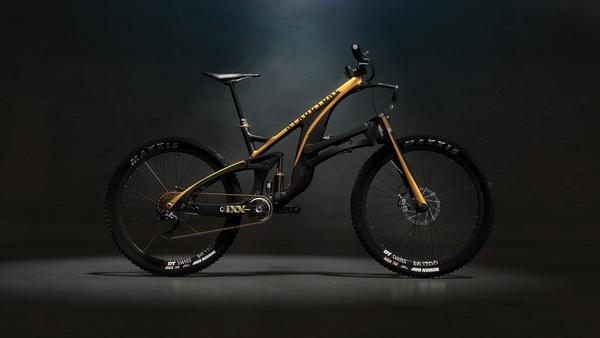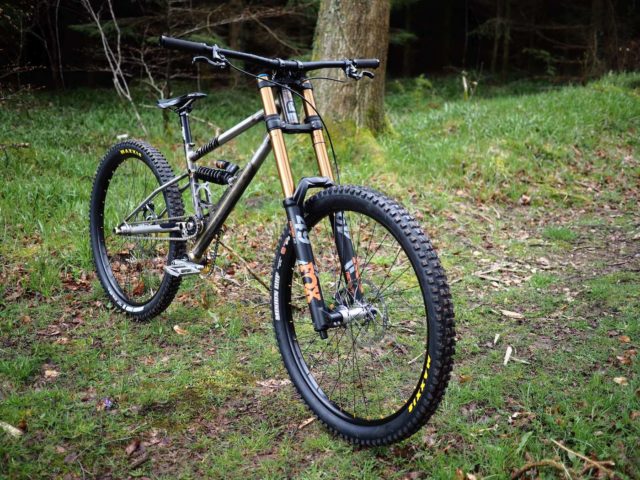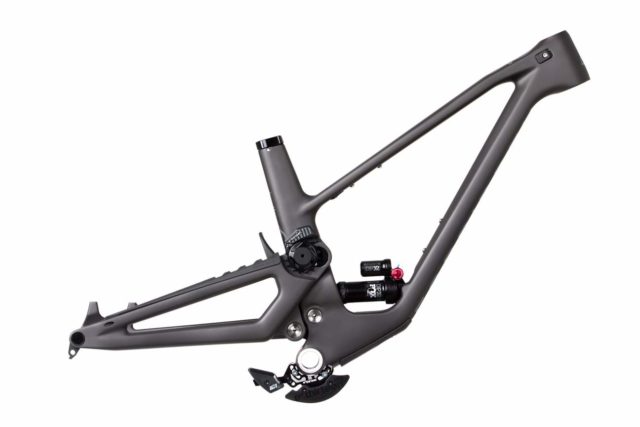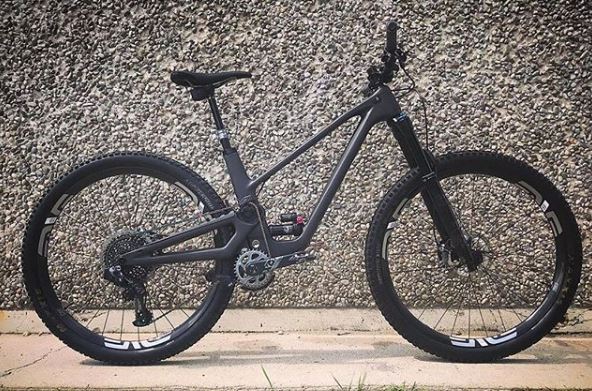TOPICS & TIMES
- Introducing David, our ‘Oddities Expert’ (2:35)
- David’s Nicolai G16, Mojo Special Edition (3:12)
- Trust Message linkage fork (4:20)
- Structure Cycleworks’ SCW1 linkage fork/frame system (13:20)
- High-Pivot Trail Bikes / the Forbidden Druid (19:12)
- Starling Cycles’ ‘Jack Drive’ bikes (25:55)
- Tannus Armour Tire Inserts (30:55)
Sometimes, “different” is better. Other times, it’s just dumb.
So today we are taking a look at a handful of very unconventional bike products that really stand out, and we’re asking: why does this product exist; what problem is it trying to solve; who is its target audience; and … is the product more likely to become the next big thing, or, is it more likely destined for the dustbin of history?







A small note: I said that the Trust is about 10mm taller than a 140mm travel Fox 36 29er fork – that was backwards, I misspoke and meant to say that the 36 is about 10mm taller.
Great looking rack
I enjoyed this episode, thank you. David is great to listen to, similar to Noah, who’s king.
I recently could ride a Geometron G1 in Large and XL ans was totally sold. With 6’1″ I was suprised how normal the Large felt and I even preferred the XL. I am looking forward to your opinion on the G16.
Having ridden the Commencal Supreme DH 29er (Large), I am very interested in your comments on the Druid. I loved the Commencal and how composed it stayed over braking bumps and over root sections. What I also liked is that it seemed it was less influenced by braking (in the rear). With other bikes, the rear suspension tends to stiffen when you apply the rear brake. I felt much more comfortable to brake on the Commencal in rough sections.
You said the Druid might be the ticket for talented riders who can attack rough sections with less suspension travel to profit from the rear wheel’s backwards travel. And you are wondering if it will be “poppy” enough. However, I could imagine that it would also be attractive to less talented, elderly riders that don’t want to jump around and who will just profit from a stable ride in general.
For me personally, I do wonder if the Druid is too heavy and too much suspension for smooth/average trail riding and not enough travel (and steep head tube) for rough Enduro (forgive me to use the current lingo for the lack of better words).
Currently I am on a Yeti SB150.
Hey Luke,
First off, thanks for the kind words, and I’m glad that you enjoyed the episode! We’re putting the finishing touches on the G16 review, and it’ll be up very soon.
I haven’t ridden the Supreme 29er, but have a few laps on the 650b version, and agree that it absolutely hauls through braking bumps and the like. As far as braking goes, I don’t remember that sticking out to me quite as clearly (to be clear, I only got 2 or 3 laps on the bike last season) but both the Supreme and the Druid do have slightly higher than average amounts of anti-rise, which should help keep the bike composed and stable under braking. We didn’t really have time to touch on that aspect in the episode, but it is one of the traits that Forbidden is touting in their marketing materials.
I don’t want to speculate too much more before I get a chance to ride one, but I think that the general line of reasoning that the Druid should be a pretty composed, stable bike for having 130mm rear travel is very likely correct. I am also with you in thinking that the head angle does strike me as perhaps a bit steep for what the bike seems like it should be capable of. Like I said in the episode, I’m very keen to ride one and find out more.
Hi David, I liked that talk, thanks
can’t wait to hear your comments on the Geometron G16 you ride.
Back in August 2005, after about 12 months looking into longer bike geometry on MTBR etc. and many discussions with long bike fan Pilot on MTBR – I bought my first G16 (27.5/27.5 Longest) after a days test ride with Chris and Paul. It was SO nice to be on a bike that fit me! I’d worried about going 4″ longer on reach, but needn’t have, standing on the bike felt so much more balanced.
Next, a year later, a second black beauty with longer chainstays (and longer shock/rear travel).
Soon that second bike was switched to a 29″ Lyric upfront for hybrid mode.
Love the 29 front end a lot.
April 2019 I upgraded again – to the G1 XLongest, again 27.5/29 hybrid mode.
To be honest, I wasn’t feeling entitled to expect a lot by way of improvements, given how superb my G16 was, but Chris described tempting improvements from the sophistication of the coil shock and, particularly, the spherical bushings. A long testride on CP’s own bike tempted me I took one away the same day.
Hi David
you got mer thinking about the rearward travel intrinsic to high pivot bikes. I had one of the first VPP bikes, an Outland VPP 3.0, the rearward travel was extreme, the swingarm went straight back on 4 little links – and when the rear wheel hit a log it really did feel as if the bike went over THEN the back wheel popped over too, I really liked it. Sadly the success was limited due to lack of decent rear shocks at the time. it was LONG ago ’99 maybe. With only 3″ or rear suspension (which felt great at the time) it wasn’t lacking pop, but then I guess it wouldn’t.
Heres a pic of the VPP 5 DH bike! with the same twin linkage below the BB
http://tinyurl.com/y5e6cl8n
Vernon Felton: “The elusive Outland VPP 5 had more than travel than most DH bikes of the time and accelerated like a rocket. It also had a way of falling apart over time…but the Outland idea eventually led to a staggering number of really great bikes from other manufacturers.”
Have you tried an Orange 5, a high single pivot machine? – Orange have a few others in the range too , with varying travel, 5 is amazingly popular here in the UK.
Hi David,
I was thinking about what you said about the Starling ‘jackdrive’ bike, you’re right that its an interesting clean approach to getting the chain up onto a virtual idler pulley inline with the high pivot. Pretty too.
As I understand it, the really important part of this feature (i.e. a bike with idler pulley chainline e.g. http://tinyurl.com/y65uncve) is that they have zero chain growth, so zero pedal kickback.
Chris Porter (Mr Geometron) had a chain idler pulley on his own (high single pivot) team Orange 22 DH bikes back in the day
Why? witness the occasional stellar chainelss performance at the WC DH. Gwin in particular. The suspension just works better without the chain pulling on it.
Of course zero chain growth means zero pedal related antis-quat too – so I’d expect such a bike to be a pretty soggy pedaller for trail / enduro unless it has strong “pro pedal” in the shock. Unfortunately, though, that ‘pro pedal’ will negatively affect small bump compliance and grip.
I’ll be really intrigued to know how the Druid pedals compared to your G16, I thought the G1 pedalled great when I owned one, nearly as good as my current Geometron G1 and certainly as good as my old Pivot 429.
Hey Neil,
I think it’s pretty important to note the difference between a jack drive bike like the Starling, and a high pivot bike with an idler on a single chain like the Druid. The former does have very little anti-squat; the exact amount varies by gearing, but it won’t be much. Like you said, it should have very active suspension, but isn’t likely to pedal very well. An idler as configured on the Druid, on the other hand, can tune the amount of anti-squat more carefully (it would be astronomical on a high pivot bike with no idler), and somewhat decouple the anti-squat value from chain growth/pedal kickback. The Druid has >100% anti-squat around sag while also having minimal pedal kickback. On paper, this suggests that it’ll pedal pretty well while having minimal interaction between the drivetrain and suspension movement. Hopefully I’ll be able to get on one soon and find out more!
I think I will not buy a new rig until a bottom bracket gearbox is available. The Pinion is a step towards this reasonable objective. It’s past time to ditch derailleurs and cassettes, I want a belt drive and cable free shifting.
Hi David
Thanks for the thoughtful reply.
You write “decouple the anti-squat value from chain growth/pedal kickback”
I thought anti squat was totally linked to chain growth. Inasmuch as when rider weight pressed down on the BB, it’s the pulling of the chain (dependent on how chain position relates to the suspension pivot point) that resists suspension movement) Looks like I need to learn more on that.
Neil,
What you wrote is more or less right for most bikes. The key difference is that the normal graphical method for calculating AS, which works in the manner you described, doesn’t hold for a bike (like the Druid) with an idler mounted on the swingarm, if it’s not concentric with the main pivot. Forbidden has anti-squat and pedal kickback graphs on their site, which are worth a look. I wish they said what gearing was used for the AS graph, but it’s still interesting.